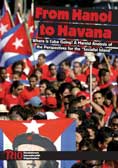




 Cuba’s economy has seen a certain stabilization since 1999 when Venezuela began shipping cheap oil in exchange for Cuban doctors. This made it possible for the government to de-dolarize the economy, introducing the convertible peso in 2004. However, to this day, two currencies exist in Cuba: the “normal” peso paid to state workers and the convertible peso, pegged to the dollar, which is available from remittances, tourists etc.
Cuba’s economy has seen a certain stabilization since 1999 when Venezuela began shipping cheap oil in exchange for Cuban doctors. This made it possible for the government to de-dolarize the economy, introducing the convertible peso in 2004. However, to this day, two currencies exist in Cuba: the “normal” peso paid to state workers and the convertible peso, pegged to the dollar, which is available from remittances, tourists etc.
Reforms introduced under Raúl Castro have allowed Cuban’s to buy mobile phones, computers and DVD players in state shops with convertible pesos, as well as staying in foreign hotels which were previously off limits to Cubans[30]. Considering that a Cuban state worker earns US$20 a month, and a DVD player costs US$100 or more, it is undeniable that social inequality on the island is growing. In recent years, the GDP has been rising while the average standard of living has not, meaning that the gap between rich and poor has been increasing. Concretely, the Gini coefficient, measuring social inequality in a country, almost doubled from 0.22 to 0.41 between 1986 and 1999[31].
The former Cuban minister of the economy, José Luis Rodríguez García, called these market mechanisms a “concession” to the market economy which was “unavoidable”, even though they contradicted the survival of the “revolutionary project”. For him, the unavoidability was a result of holes in the plan: these holes, which would automatically be filled by the (black) market, should at least be subject to state controls. But his only recipe for guaranteeing the survival of the planned economy was the “political and moral values” of the Cuban people, rather than any concrete economic or political structures[32]. Similarly, the “Friends of Cuba” put their faith in the convictions of the leadership or in the consciousness of the population, while recent economic reforms are preparing the foundations for the restoration of capitalism.
These reforms have been defended, by some Marxists, as comparable to the New Economic Policy (NEP) in the Soviet Union, which was introduced after the civil war to restart the economy. However, the private sector which emerged under the NEP was under the strict control of the bureaucracy of the workers’ state. In Cuba, in contrast, it is the bureaucracy itself, principally the military, that is profiting from the economic reforms.
Notes:
30. New York Times: “Cuba removes restrictions on sale of computers and DVD players”. New York Times. 13. März 2008.
31. Stuart King: “Cuba: The Last Workers’ State?” In: Permanent Revolution. #10. Herbst 2008. London. P. 39.
32. Rodríguez García: “Economic Recovery”. P. 150-151.
Leave a Reply
